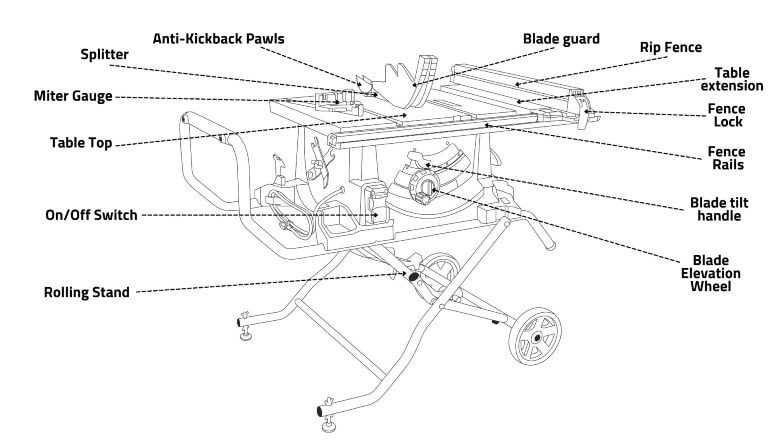Table saws are one of the most common power saws found in virtually every woodworker or contractor’s garage. While they may seem fairly straightforward to use, table saws have specs and parts that can be confusing. To dispel that uncertainty, this article details all you need to know about table saws, from their various specifications to all of the parts you are liable to interact with.
Table Saw Basics: Specifications Explained
Amperage
If you think about electricity as a flow, then amperage is the amount of “water” flowing through the current. Keep in mind that this does not refer to how the speed or strength of the current, just the amount of electricity or electrons flowing. That said, the amperage tends to be one of the most important specs when considering the power of a table saw, as it impacts the saw’s ability to maintain power while cutting or “under load.” For light work, 5 to 10 amps should be fine, but heavy-duty work requires 12 or more amps for the best results.
Horsepower
Horsepower is what many people think of when they consider the power of a motor or engine, but it is actually a combined rating. You derive the horsepower from the amps combined with the voltage, though efficiency also comes into play. Since many motors tend to run between 50% to 70% efficiency, the horsepower and amps can vary significantly. While not the best metric, this gives you a solid rough idea of motor power without digging any further.
RPM
Rotations per minute, or RPMs, can actually refer to a couple of different specs, depending on the manufacturer. With table saws, RPMs tend to refer to the number of rotations the blade makes in a minute. However, some manufacturers provide the arbor’s RPMs if the blade RPMs are not quite as impressive. This is generally what people mean when they talk about “blade speed,” and it matters more depending on the density of the material you cut.
Does table saw RPM matter? The short answer is no. RPM matters only in the context of table saw design and is not the most important buying consideration.
Voltage
Voltage refers to the difference in electric potential and the work required to push an electric charge between two different points. Table saws will either come in 120V or 240V ratings, with the latter being able to push more energy to the motor than the former. While this may not necessarily be quite as important for general functioning, it becomes far more important for heavy-duty work. If you have a cabinet or hybrid table saw, it is a good idea to look for one that works on 240V.
Watts
Watts is another combined spec that finds more applications in the international market. While this rating may be less common in American markets, it multiplies the volts with the amps to provide a sense of the real power a motor can push. The good news is that it is much more difficult for manufacturers to “fudge” the numbers with watts compared to some of the other power ratings. However, Americans are not used to thinking about large electric power in terms of watts.
Read More: How Much Power Does A Table Saw Need?
Rip capacity
The rip capacity refers to the maximum width of a workpiece that you can feed into the blade. It is important to remember that rip capacity can be measured both to the right and left of the blade. However, if a manufacturer only provides a single rip capacity, it almost always refers to the capacity to the right of the blade. Given that this can limit the size of your projects, it is often one of the more important specs.
Dado capacity
A dado is a cut made into the workpiece that does not go all the way through the workpiece and forms a trench. The dado capacity of a dado refers to the width of the cut and trench made in the workpiece, unlike the size of a traditional blade, which refers to its diameter. Dado blades come in wobble or stacked types with the latter offering an adjustable capacity but requiring more skill and knowledge.
Cutting depth
Alongside the rip capacity, the cutting depth is the other cutting size spec that matters a bit more than most. That said, the cutting depth is not as simple as taking the radius of the blade and calling it a day. Since the arbor sits below the table, the cutting depth will always be less than the radius of the blade. Depending on how low the blade sits will determine how large the cutting depth is compared to the blade size.
Blade size
The blade size is measured in terms of the diameter of the blade. This is not necessarily the most important factor, but you generally cannot use a blade of the wrong size– even if it is smaller. Most table saws use blades that are either 10” or 12” in diameter, though some benchtop models use 8 ¼” blades. Even smaller “mini” table saws exist, but they are either specialized or consumer-grade.
Bevel capacity
Bevels are cuts made into a workpiece at an angle that is not in line with one of the faces. The capacity often refers to the maximum bevel angle, measured in degrees, but can also include considerations of positive stops. For the most part, beginning woodworkers and contractors can get away with a 45° bevel and no other positive stop. That said, if you are an experienced woodworker or professional carpenter, other bevel sizes might occasionally be necessary.
Motor types
A direct-drive motor connects the arbor directly to the motor which allows for a more efficient transfer of power from the motor to the blade. A belt drive motor, on the other hand, connects a belt to the motor, which then drives the blade.
While a belt-drive motor may see a less efficient transfer of power to the blade, it compensates for this with a stabler cut. A direct-drive motor is liable to introduce vibration to the blade, causing it to cut less precisely.
Further Reading: All You Need To Know About Table Saw Motors
Space for storage
These days, most table saws come with some feature that allows you to store either accessories or even workpieces in the table saw’s housing. However, smaller benchtop table saws generally have less storage and may ever use hooks or some other exterior storage method. Larger cabinet table saws often allow you to store all of the saw’s accessories as well as additional blades and maybe even workpieces.
Table Saw Parts Explained
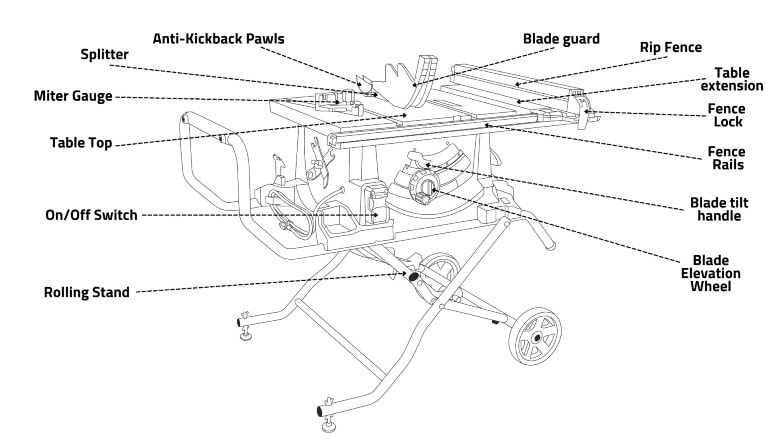
Tabletop
The table top is the part of a table saw where the workpiece sits as you feed it into the blade. This is one of the more important parts of a table saw, as its straightness will impact the precision of the cut. On top of that, the density of the table can reduce the vibrations that travel from the motor and would otherwise throw off the cut precision even more.
On/off switch
The on/off switch controls whether or not the motor receives power and spins the saw blade. While many smaller benchtop models use an actual switch for this part, larger table saws often include large buttons. The large buttons are also generally mounted lower on the saw and can be activated by your knee. This is a safety measure that allows you to quickly kill the table saw should your clothing get caught in the blade.
The blade
The blade is the part of the table saw that cuts the workpiece and comes in a variety of types and sizes. Of the two, it is vital that you use the right size of the blade for your table saw to prevent injury to yourself or harm to the tool. After that, consider the number of teeth, the material of the blade, and the geometry of the teeth to choose the right type of blade for the cutting task you need.
Throat plate
The throat plate is a removable piece of the table saw’s table that allows you to access the arbor and blade underneath. While often metal, some lower-grade throat plates are made out of plastic, though these do not hold up as well. Zero-clearance throat plates help prevent tear out with edges positioned right next to the teeth of the blade. Read more about the benefits of using a zero-clearance table saw insert here.
Arbor
The arbor is a shaft in the table saw that holds the blade and determines the size of the blade you need to use. Some arbors are adjustable in terms of their size, but most are not. The arbor either connects directly to the gear works turned by the motor or the belt. Arbors range from ¼” to 1” in diameter, with ⅝” and 1” being the most common sizes for table saws.
Elevation and tilt handles/wheels
The elevation and tilt handles or wheels allow you to raise or lower the blade as well as tilt it. Tilting the blade allows you to make bevel cuts, though this also means you generally cannot use zero-clearance throat plates while doing so. Wheels generally accompany larger table saws, while smaller models will use handles.
Blade guard
A blade guard is a plastic or metal cover that sits over the blade and helps protect you from it while cutting. Keep in mind that the blade guard only protects you from the top of the blade. Some manufacturers use blade guards with tool-less removal to make changing the blade easier.
Riving knife
A riving knife helps keep you safe by making sure the two faces of a workpiece being cut do not pinch or bunch up. This function helps prevent the workpiece from kicking back and potentially injuring you. Furthermore, the riving knife mounts directly onto the blade’s arbor and raises or lowers with the blade.
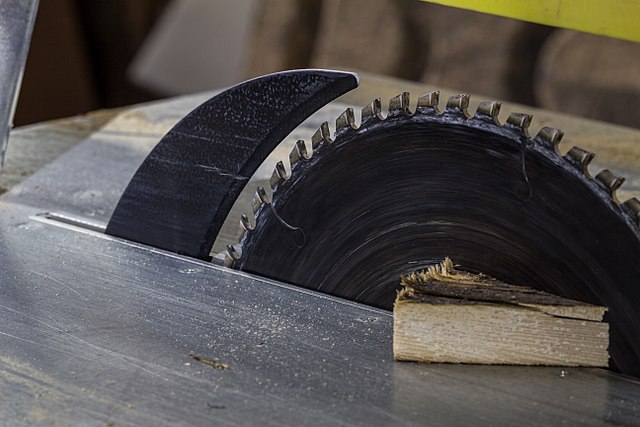
Dust collection system
While technically, any type of feature that removes dust from the table saw while it cuts is part of the dust collection, this generally refers to a feature integrated with some blade guards. A port at the top of the blade guard allows you to attach a vac hose that sucks out the dust as you cut. While this can be an incredibly convenient dust collection system, its efficacy depends on the vac power and flow rate.
Stand
Only smaller table saws come with a stand, which is a component that you mount onto the housing of the table saw. A stand allows you to move the table saw around and keep it at the best height for you. More often than not, stands are included with benchtop table saws, but not many other types.
Cabinet
Technically, every table saw comes with a cabinet, but that is not often what manufacturers mean when they refer to a cabinet. Instead, a cabinet generally refers to a specific type of housing for larger table saws. While the eponymous cabinet table saw is one, hybrid table saws also often have a cabinet. Table saws with a cabinet tend to be more powerful and precise than a table saw with a smaller housing.
Table Saw Accessories Explained
Rip fence
The rip fence is technically an accessory to the table saw, though most models these days come with one. A table saw rip fence serves as a guide for the outer face of the workpiece, allowing you to keep the workpiece straight while feeding it into the blade. More often than not, the rip fence is made of metal to stand up to the pressures of the cut and may be treated with an anti-stick coating to make sliding the workpiece smoother.
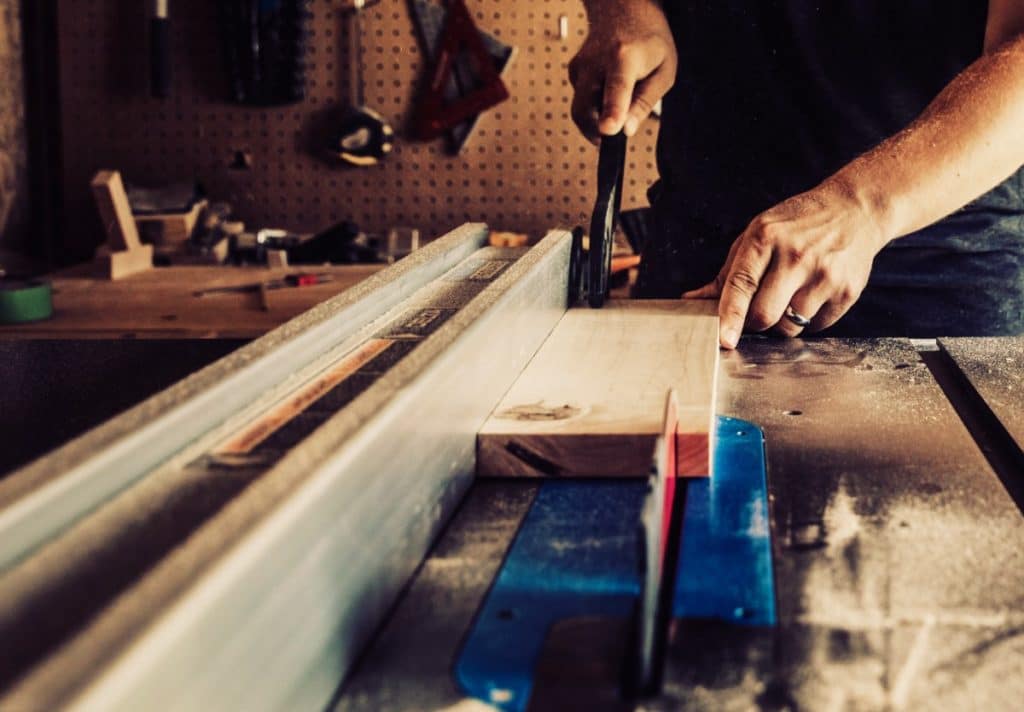
Fence lock
The fence lock is actually a part of the rip fence that allows you to fasten it to the table of your saw. Some older models use a bolt-on fence lock that is incredibly sturdy but also takes more time and energy to use. A more common contemporary fence lock is the cam design, which allows you to lock the fence in place with a lever.
Miter gauge
A miter gauge is somewhat similar to a fence in purpose, though it might look very different. Generally, table saw miter gauges are made out of metal, though some are made of plastic. The miter gauge allows you to adjust the straight edge by degrees so miter cuts are accurate and precise.
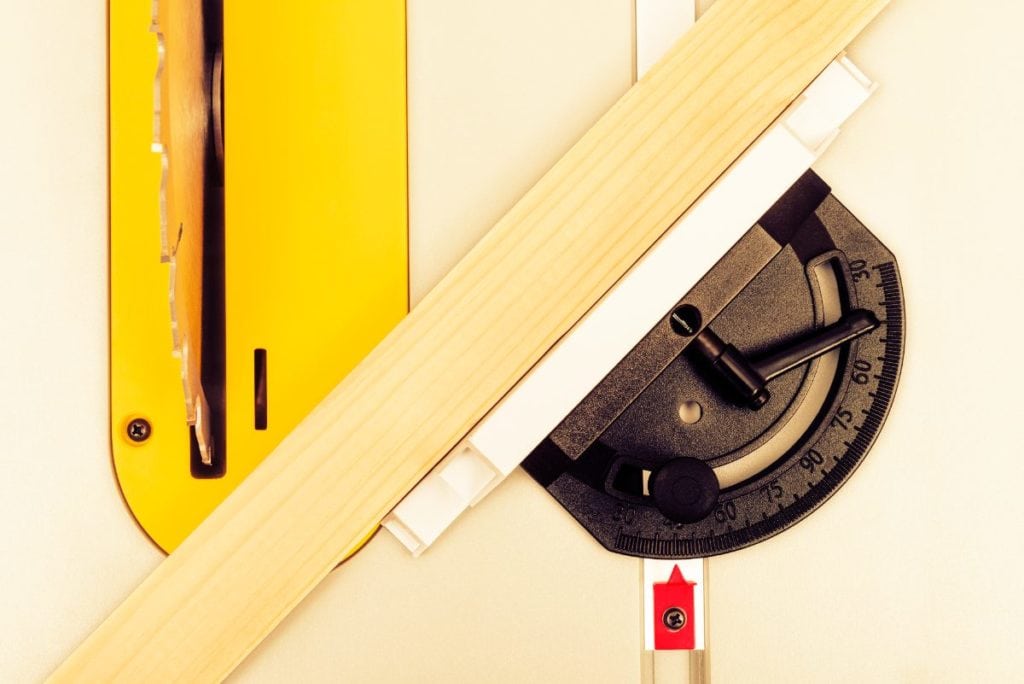
Splitter
A splitter is similar to a riving knife, except it does not affix to the saw’s arbor like a riving knife. This means that, unlike a riving knife, a splitter stays in the same place regardless of the blade’s height. This can allow for the workpiece to pinch in between the blade and splitter when the blade is set low.
Anti-kickback pawls
Anti-kickback pawls are another safety device designed to prevent kickbacks and are generally attached to the riving knife or splitter. The anti-kickback pawl employs two pieces of metal with teeth angled away from the blade. This allows you to feed the workpiece into the blade but causes the teeth to catch the workpiece should it kick back out.
Magnetic switch
A magnetic switch works to protect you from injury should the power go out while using the table saw. Essentially, if you lose power, the magnetic switch prevents the saw from automatically turning back on when the power does.
Table extensions
Table extensions are often optional accessories that allow you to increase the rip capacity of a table saw. Table extensions connect to the table of a table saw, generally with a rack and pinion system. This allows you to adjust the size of the extension as needed, with some extensions providing a maximum 52” rip capacity.
Featherboard
Featherboards are another safety component that acts as a fence of sorts on top of the workpiece. More often than not, purchased feather boards attach to the fence and help keep the workpiece straight along the fence’s edges. Because of the angled fingers, a feather board also helps prevent kickback.
Crosscut sled
A crosscut sled is somewhat similar to a fence, except it moves with the workpiece. Crosscut sleds are useful because the longer edge of the workpiece tends to run with the grain. You position a crosscut sled behind the workpiece to feed the workpiece into the blade.
Push stick
Push sticks are safety accessories that allow you to feed the workpiece into the blade without having to worry about getting your hands and fingers close. While a push stick might be thick enough to be considered a “block,” the traditional push stick is meant to be used for making thinner rip cuts. This ensures that you can maintain control over the smaller workpiece without having to place your finger near the blade.
Dust bag
Unlike other types of power tools, where a dust bag attaches directly to the tool, which sucks up and collects dust, a table saw’s dust bag sits under the saw. In this instance, the dust bag catches falling dust particles as they sift through the saw’s body. While not terribly helpful in keeping the cutting area clear, a dust bag makes cleanup much easier.
Dust chute
While some table saws try to target dust at the source with dust collection mounted to the blade guard, that is far from the norm. Traditionally, table saws include a dust chute embedded in the housing of the table saw, which collects dust as it falls through the body. Table saw dust chutes generally come in sizes of 1 ¼”, 2 ½”, and 4”, with many models allowing for multiple sizes.
Dado blade
As mentioned previously, dado blades are used to cut trenches out of workpieces and come in a couple of different varieties. The wobble dado blade is the standard model, and the blade spins in an “S” pattern that leaves a slight curve in the cut. Stacked dado blades come in a set with blades and chippers that you can add or remove to adjust the size of the dado cut. Stacked dado blades leave a straight edge and are more precise.
Mobile base
Opposite the cabinet, a mobile base is a part of some table saws that make it far more portable than it otherwise would be. Keep in mind that most table saws have a mobile base attached to the base, though some have the base built directly into the housing. Generally, a table saw with a mobile base is meant to be taken to a job site. As such, these table saws find most of their use with contractors and other professionals.
Summary
As you can see, when you break down a table saw into its various parts and specs, what was once a confusing topic is fairly straightforward. Outside of industry-specific terms and jargon, table saws really only involve a handful of unique concepts. Now that you know all about table saw basics. Read our guide, which will teach you which table saw to buy.

